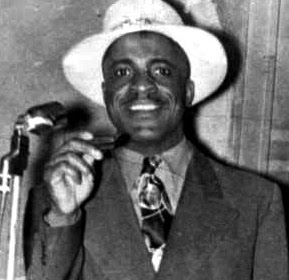Sonny Boy Williamson I facts for kids
Quick facts for kids
Sonny Boy Williamson I
|
|
|---|---|
 |
|
| Background information | |
| Birth name | John Lee Curtis Williamson |
| Born | March 30, 1914 Madison County, Tennessee, U.S. |
| Died | June 1, 1948 (aged 34) Chicago, Illinois |
| Genres | Blues |
| Occupation(s) | Musician, songwriter |
| Instruments | Singing, blues harmonica |
| Years active | 1930s–1948 |
| Labels | Bluebird |
John Lee Curtis "Sonny Boy" Williamson (born March 30, 1914 – died June 1, 1948) was an American blues musician. He was a talented harmonica player, singer, and songwriter. Many people see him as the first person to make the blues harmonica a main instrument in blues music.
He played on many recordings for other blues artists before World War II. He was one of the most recorded blues musicians in the 1930s and 1940s. He worked closely with producer Lester Melrose and Bluebird Records. Some of his famous songs include "Good Morning, School Girl" and "Stop Breaking Down".
Sonny Boy Williamson I's harmonica style greatly influenced later musicians. He also helped many young blues artists who moved to Chicago, like Muddy Waters. Another musician, Aleck "Rice" Miller, started using the name Sonny Boy Williamson. To tell them apart, John Lee Williamson became known as Sonny Boy Williamson I or "the original Sonny Boy."
Contents
Early Life and Music Career
Williamson was born in Madison County, Tennessee, near Jackson, in 1914. His first recordings were in the country blues style. But he quickly showed how good he was at making the harmonica a lead instrument. He made the harmonica popular in city blues music for the first time. Some call him "the father of modern blues harp."
When he was a teenager, he played music with Yank Rachell and Sleepy John Estes in Tennessee and Arkansas. In 1934, he moved to Chicago.
Williamson first recorded in 1937 for Bluebird Records. His first song, "Good Morning, School Girl", became a very popular blues song. He was well-liked by Black audiences across the southern United States and in big cities like Detroit and Chicago. For about ten years, his name was known for blues harmonica music. In 1947, his song "Shake the Boogie" reached number 4 on Billboard's Race Records chart.
Williamson's style influenced many harmonica players. These included Billy Boy Arnold, Junior Wells, Sonny Terry, Little Walter, and Snooky Pryor. He was the most heard and important blues harmonica player of his time. His music also influenced other musicians who didn't play harmonica. This included Muddy Waters, who played guitar with Williamson in the mid-1940s. Many artists, both blues and rock, have helped keep his songs popular by recording them again.
Williamson recorded many songs. He recorded as the leader of his own band and also played with other musicians. Most of his recordings were for Bluebird Records. Many early recording sessions happened at the Leland Tower hotel in Aurora, Illinois. The Sky Club, a nightclub on the top floor, was used for live radio shows. When it wasn't being used for live shows, it became a recording studio for Williamson and other Bluebird artists.
His Death and Lasting Impact
Williamson's last recording session was in Chicago in December 1947. He played with Big Joe Williams. On June 1, 1948, Williamson was killed during a robbery in Chicago. He was walking home from a show at the Plantation Club. This club was very close to his home. People say his last words were "Lord have mercy."
Williamson is buried near Jackson, Tennessee. In 1991, fans and family bought a red stone marker for his grave. Also in 1991, a Tennessee historical marker was placed. It shows where he was born and explains how much he influenced blues music.
Understanding His Name
Sonny Boy Williamson I's lasting impact has been a bit confusing. This is because another musician, Rice Miller, became very popular after Williamson's death. Rice Miller started using the name Sonny Boy Williamson. People believe Miller used the name to make audiences think he was the "original" Sonny Boy.
To help tell them apart, many experts and writers now call John Lee Williamson (1914–1948) "Sonny Boy Williamson I." They call Miller (who lived from about 1912–1965) "Sonny Boy Williamson II."
Music Albums
Williamson's songs were first released on 78 rpm records by Bluebird Records. Bluebird was part of RCA Records. Later, RCA released many collections of his music. Some of these include:
- Big Bill & Sonny Boy (RCA, 1964)
- Bluebird Blues (RCA, 1970)
- Rare Sonny Boy (1937-1947) (RCA, 1988)
- RCA Blues & Heritage Series: The Bluebird Recordings, 1937-1938 (RCA, 1997)
- RCA Blues & Heritage Series: The Bluebird Recordings, 1938 (RCA, 1997)
- When The Sun Goes Down: The Secret History of Rock & Roll, Vol. 8: Bluebird Blues (RCA Victor, 2003)
Other music companies have also released his collections. In 1991, Document Records put out all of Williamson's recorded songs on five CDs.
See also
 In Spanish: Sonny Boy Williamson I para niños
In Spanish: Sonny Boy Williamson I para niños

